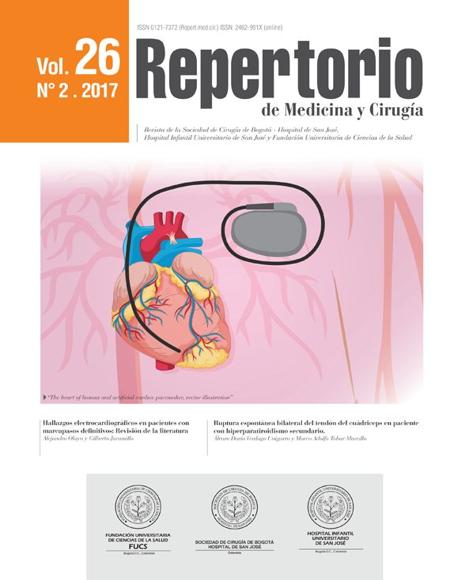Electrocardiographic findings in permanent pacemaker patients: A literature review
Hallazgos electrocardiográficos en pacientes con marcapasos definitivos: revisión de la literatura
![]()
![]()

Show authors biography
Cardiac [artificial] pacemakers have been part of the therapeutic arsenal for the treatment of a variety of bradyarrhythmias during many decades. With the development of pulse generators, pacemakers are now smaller in size and have increased device longevity and complexity. The latest pacemakers have the ability to detect rhythm and provide cardiovascular disease states. Several algorithms were designed to offer a time to deliver a stimulus pulse. Even more modern pacemakers are capable to provide diagnoses which indicate cardiovascular physiopathology. The use of stimulation has increased significantly from 46.7/100.000 in 1993 to 61.6/100.000 in 2009, showed by the dual chamber device use rate which has increased from 62 to 82% during this period, with around 20.000 upgrades perfor- med yearly in the United States. The electrocardiographic traces vary according to the type of device, number and location of electrodes, as well as their configuration. Doctors must be familiar with these findings and have an understanding of the main causes of malfunction. This review was undertaken for that purpose showing the main features of pacemaker functioning, as well as, the correct interpretation of electrocardiographic traces and the main causes of malfunction.
Article visits 1205 | PDF visits 690
Downloads
1. Reynolds J. Historia de los marcapasos en Colombia. RCC. 1985;1:1014.
2. Ostabal A, Fragero B, García C. Los marcapasos cardíacos. Med Integr. 2003;41:151–61.
3. Ochagavía A, Baigorri F. Selección del modo de estimulación del marcapasos. Med Intensiva. 2006;30:8–22.
4. Bernstein AD, Parsonnet V. Survey of cardiac pacing in the United States in 1989. Am J Cardiol. 1992;69:331–8.
5. Samartín RC, de Carranza MJS-T, Mateas FR, del Ojo González JL, Andrés MLF. Registro español de marcapasos VIII Informe Oficial de la Sección de Estimulación Cardíaca de la Sociedad Española de Cardiología (2010). Rev Esp Cardiol. 2011;64:1154–67.
6. Orjuela A, Vanegas DI, Montenegro J. Experiencia en implante de dispositivos de estimulación cardiaca. RCCC. 2006;12:438–42.
7. Morgan JM. Basics of cardiac pacing: selection and mode choice. Heart. 2006;92:850–4.
8. Hayes D, Link M, Downey B. Permanent cardiac pacing: Overview of devices and indications [Internet]. 2015; [consultado 14 Oct 2016]. Disponible en: http://www.uptodate.com.
9. Bernstein AD, Camm A, Fletcher RD, Gold RD, Rickards AF, Smyth NP, et al. The NASPE*/BPEG** Generic Pacemaker Code for Antibradyarrhythmia and Adaptive Rate Pacing and Antitachyarrhythmia Devices. Pacing Clin Electrophysiol. 1987;10:794–9.
10. Hosoda J, Ishikawa T, Sumita S, Matsushita K, Matsumoto K, Kimura Y, et al. Development of atrioventricular block and diagnostic value of stored electrograms in patients with sick sinus syndrome and implanted pacemaker. Circ J. 2015;79:1263–8.
11. Hayes D, Link M, Downey B. Modes of cardiac pacing: Nomenclature and selection [Internet]. 2016; [consultado 15 Oct 2016]. Disponible en: http://www.uptodate.com.
12. Sugihara C, Veasey R, Freemantle N, Podd S, Furniss S, Sulke N. The development of AF over time in patients with permanent pacemakers: objective assessment with pacemaker diagnostics demonstrates distinct patterns of AF. Europace. 2015;17:864–70.
13. Dretzke J, Toff WD, Lip GYH, Raftery J, Fry Smith A, Taylor RS. Dual chamber versus single chamber ventricular pacemakers for sick sinus syndrome and atrioventricular block. Cochrane Database Syst Rev. 2004. CD003710.
14. Shurrab M, Elitzur Y, Healey JS, Gula L, Kaoutskaia A, Israel C, et al. VDD vs DDD pacemakers: a meta-analysis. Can J Cardiol. 2014;30:1385–91.
15. Andersen HR, Thuesen L, Bagger JP, Vesterlund T, Thomsen PEB. Prospective randomised trial of atrial versus ventricular pacing in sick-sinus syndrome. The Lancet. 1994;344:1523–8.
16. Connolly SJ, Kerr CR, Gent M, Roberts RS, Yusuf S, Gillis AM, et al. Effects of physiologic pacing versus ventricular pacing on the risk of stroke and death due to cardiovascular causes. N Engl J Med. 2000;342:1385–91.
17. Lamas GA, Lee KL, Sweeney MO, Silverman R, Leon A, Yee R, et al. Ventricular pacing or dual-chamber pacing for sinus-node dysfunction. N Eng J Med. 2002;346:1854–62.
18. Lamas GA, Orav EJ, Stambler BS, Ellenbogen KA, Sgarbossa EB, Huang SKS, et al. Quality of life and clinical outcomes in elderly patients treated with ventricular pacing as compared with dual-chamber pacing. N Eng J Med. 1998;338:1097–104.
19. Rodríguez J, Lopez-Guasch C, Coma R, Ruiz E, Alonso M. Síndrome del marcapasos por fracaso incorregible de la estimulación bicameral. Hallazgos de electrocardiografía en pacientse con marcapasos. Cuadernos Técnicos de Estimulación Cardiaca. 2005;11:29–35.
20. Prutkin JM, Goldberger A, Saperia GM. ECG tutorial: Pacemakers [Internet]. 2016; [consultado 15 de Oct 2016]. Disponible en: http://www.uptodate.com.
21. Cardall TY, Chan TC, Brady WJ, Perry JC, Vilke GM, Rosen P. Permanent cardiac pacemakers: issues relevant to the emergency physician, part I. J Emerg Med. 1999;17: 479–89.
22. Lloyd MS, El Chami MF, Langberg JJ. Pacing features that mimic malfunction: a review of current programmable and automated device functions that cause confusion in the clinical setting. J Cardiovasc Electrophysio. 2009;20: 453–60.








